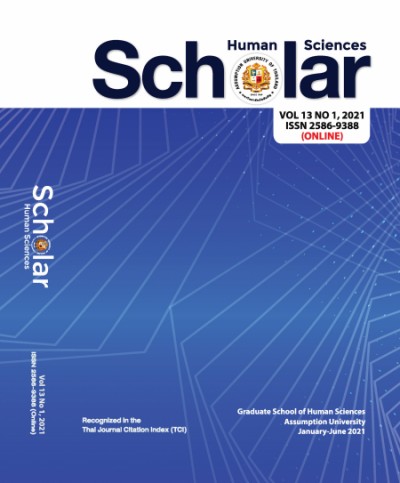Development of a Service-Learning Model Based on Blended Learning Method to Enhance Critical Thinking for Students in Higher Education
Keywords:
Service-Learning, Blended Learning Method, Critical Thinking, Kamphaeng Phet Rajabhat UniversityAbstract
The purpose of this research was to develop a service-learning model based on blended learning method to enhance the critical thinking for students in higher education. A content analysis was performed on papers collected from the literature related to this kind of model. The findings from the analysis were used to construct a draft model. Then, the draft model was evaluated by 5 experts in instructional management with an evaluation form for analyzing data collected from a focus group discussion of those experts, and the results were used to construct the final model. The statistics used in the analysis were mean ( ), standard deviation (S.D.) and percentage. The draft model achieved a high level of appropriateness of = 4.29 with S.D. = 0.46 from the experts’ evaluation. Both the draft and final models consisted of 5 components: 1) collaboration, 2) preparation, 3) process, 4) assessment and 5) reflection, but the final model incorporated suggestions from the focus group discussion regarding instruction method, process learning and community selection.
References
Allen, I. E.; Seaman, J.; & Garrett, R. (2007). Blending in: the extent and promise of blended education in the United States. United States: Sloan Consortium.
Anchana Suksomchit. (2013). Development of service learning model using computer as a support for collaborative learning project work to raise public awareness of undergraduate students at Rajabhat University. Bangkok: Chulalongkorn University.
Banjong Amornchiwin (2013). Critical Thinking, Thinking Developing Principles with logic, reason and discretion. Bangkok: Phappim Limited Partnership.
Boonliang Thumthong. (2016). Theory and development of learning management model. (2nd ed), Bangkok: S. Printing Factory.
Bonk C.J., and Graham C.R. (2006). The handbook of blended learning: global perspective. Local designs. San Francisco: Pfeiffer.
Cathryn Berger Kaye, M.A. (2010). The Complete Guide to Service Learning: Proven, Practical Ways to Engage Student in Civic Responsibility, Academic Curriculum, & Social Action. States of America: Free Spirit Publishing Inc.
Chalinuch Khonsue. (2011). Development of blended learning model with activities in system analysis and system design course of Rajamangala University of Technology Isan, Sakon Nakhon Campus. Bangkok: King Mongkut's University of Technology North Bangkok.
Chawala Wechayan. (2001). Development of education model with service learning techniques to enhance service awareness, problem solving skills and the academic achievement for lower secondary school students. Bangkok: Chulalongkorn University.
Decaroil, M.H. (1973). What Research Say to the classroom Teacher : Critical Thinking”. 67-68: Social Education.
Department of Academic Services and Income Procurement. (2017). Project report summary: Pee Son Nong Mong Technology Activities for Academic Year 2017. Kamphaeng: Kamphaeng Phet Rajabhat University
Dressel, P.L., & Mayhew, L.B. (1954). General education: exploration in education. Washington, DC: American Council on Education.
Ennis, Robert H. & Eric Weir. (1985). The Ennis-Weir Critical Thinking Essay Test: Test, Manual, Criteria, Scoring Sheet: An Instrument for Teaching and Testing, Pacific Grove. CA: Midwest Publications.
Kamphaeng Phet Rajabhat University. (2017). General information: philosophy, vision, mission, motto, values, and identity. Kamphaeng: Kamphaeng Phet Rajabhat University.
Kathy L.G & Holly M.C. (2010,July). Reflective Pedagogy: Making Meaning in Experiential Base Online Course.the journal of Education Online, 7(2), Retrieved from: https://files.eric.ed.gov/fulltext/EJ904075.pdf
Kerrissa Heffernan.(2011). Service learning in higher education. Retrieved 15 October 2018, from: https://opensiuc.lib.siu.edu/cgi/viewcontent.cgi?article=1160&context=jcwre
Ministry of Education. (1999). The National Education Act 1999, Amendment No.2 (2002) and Amendment No.3 (2010). Government Gazette, 116(74), Office of the Council of State.
Natalija Mazeikiene.(2008). Benefits of Service-Learning: Evaluation from Student and Communication. Socialiniai tyrimai / Social Research. 1(11), 53-66. Retrieved from: http://www.su.lt/bylos/mokslo_ leidiniai/ soc_tyrimai/2008-11/balciuniene.pdf
Panita Wanpirun. (2008). Development of blended web-based learning model with problems for critical thinking development for the Bachelor's Degree students. Doctor of Education in Educational Technology and Communications Program. Chulalongkorn University.
Sally, B. (2015). Service learning: A Guide to Planning, Implementing, and Assessing Student Project. (2nd ed), United States of America: Skyhorse Publishing.
Singh, H. (2005). Building effective blended learning programs. Retrieved 5 October 2018, from: http://www.bookstoread.com/framework/blended-learning.pdf
Songkram Meboonya. (2015). Development of educational model to enhance the consciousness of undergraduate students using social services with computer to support learning. Doctor of Education in Educational Technology and Communications Program, Chulalongkorn University.
Thitsana Khammanee. (2014). Teaching science for effective learning process management. Bangkok: Dan Sutthakan Printing Company Limited.
Weigert, K.M. (1998). Academic Service Learning: A Pedagogy of Action and Reflection. New Directions for Teaching and Learning. San Francisco: Jossey Bass.University.




